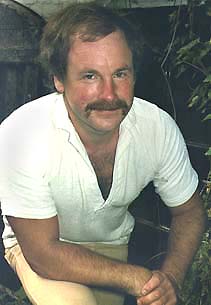
 |
| The Art of CORNELIUS ROGGE |
Below we shall feature photos of some of his objects and an introduction to some of his exhibitions. |
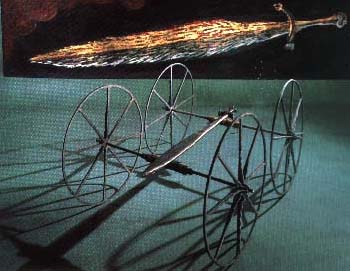 |
Apart from being a commonly used everyday term, metamorphosis is also a mythological term. In many myths and legends it refers to the continued survival of a creature in another form, as a symbol of the unbroken life cycle. At the same time it demonstrates the multiformity of the natural cycle, as expressed in the changing seasons, the phases of day and night and the stages from birth to death. Mortality, vulnerability and dissolution lead to rejuvenation and rebirth and as such are only the minuscule, ever recurring stages of life S cycle, the ever changing forms in which this unbroken process continues.
The term metamorphosis could be used to describe the whole of Cornelius Rogge's oeuvre. The work that he has been producing now for some three decades has been subject to continual transformations. This seems to be a requisite observation - after all, every artist 's work develops in this sense - but in Rogge's case there is no question of there being a logical, linear development, of steps which, being based on previous work, contain an accumulation of knowledge and experience.
From time to time Rogge unexpectedly shakes off his old garb and dons another. Therefore it's possible to describe his oeuvre as a series of groups of works with a related form. The moments of metamorphosis occur in silence, balancing between the certainty of the death of the old form and the uncertainty about the rebirth of a new one. This essential process can only be seen when viewing Rogge's work as a whole, or at least the greater part of it. As far as appearances go, in his case an individual work is no pars pro toto'. However, in its own unique way, each work is an expression of a highly personal situation in which, unaffected by developments in the 'surrounding' visual arts. the form's aho visions are supplied exclusively by Rogge's own interests and individual awareness.
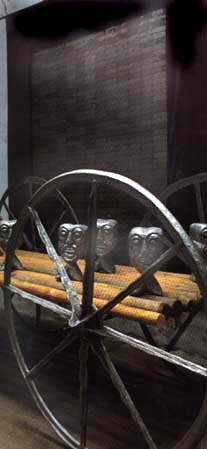 |
Intensified by Rogge's theosophical background, an important pillar in this is the realization of the subordinaton of the human being to existence, of the insignificant link that human beings form in the life cycle. After all, theosophy seeks the true nature of life, the soul essence, the divine, the mystery. Searching for the mystery in his own way, Cornelius Rogge has been moulding his personal mythology for years, creating and recreating it in ever new forms, which often cause the osberver to become confused and uncertain.Each succession of related works in Rogge's oeuvre arises from an abstract concept, moves towards a concrete phase as if to a sort of climax and finally turns back towards the conceptual and thereby more or less to the starting point. The concrete becomes the condition for the abstract. The essence of Rogge's work is represented in the form of concrete objects: tents, tables, windows, towers, wagons, as if the observer is being given a hand.
Rogge himself speaks of 'vulgar offers'. However. this conceals a double meaning that needs to be seen. It's necessary to shift the attention from the material, the outer form of the objects, to the objects themselves. or rather, to the essential nature of what they represent. However, it's not easy to expose the layer of meaning behind the outward appearances because Rogge's mythology is not one of finished stories, there is no logical content to unfurl before the observer's eyes whilst following the series of works. We can only try to reach the essence through fragments.
At the - not identical - exhibitions in Almere and Diepenheim, Cornelius Rogge exhibits wagons, swords, heads and masks. The wagons and swords were there first. The guy ropes of Rogge's earlier tents. the joists of the towers and tabernacles, became the spokes of wagon wheels. The closed covering has been removed; what remains is the open, exposed framework. Rogge's hermetic structures didn't surrender their innermost secrets, on the contrary, the wagons appear to have noth ing to hide. They display their loads in all openness: a large sword or a row of heads, both male and female. Yet when one attempts to approach and explain them, they appear to be unyielding.
The wagons could have carried the swords to a battlefield. Whether, where and when this may have taken place, however, remains unclear, as does the possible destination of the human heads. No meetings occur, no battles, no reconciliations, we are only handed attributes rich in associations. The sword, so often the hero's attribute endowed with magical powers by the gods. is made anthropomorphic by Cornelius Rogge, at least it brings to mind a stylized, elongated body with a small head and short arms. Because of the way the artist has modelled it and cast it in iron, it takes on a certain - human - softness and is robbed of its aggressiveness. The hero and the sword melt together. After his heroic death, the myth leaves the hero to enter eternity, lying on his funeral bier, the sword laid lengthways on his corpse. Perhaps Rogge's wagons testify to another, intangible world. That of the dead?
Later the wagons become lighter, finer, less substantial. The heavy, 'earthy' cast iron is replaced by the lighter, 'gleaming' cast aluminium. These wagons no longer carry swords. but heads of the same material, resting on a footboard made of wooden planks. At first the comparatively small heads seem to light a load for the enormous wagons. Cornelius Rogge refers to the heads as 'souls'. He hasn't given them the character of a portrait. but of an archetype, a female and a male on separate wagons. This character has a stimulating effect on the observer, who tends to see a direct relationship between the power of the archaic and the immanence of the transcendental, the higher, the divine.
Rogge's heads are gripping and disconcerting because of their archaic form. We can't quite say why, and because of this they become even more the obvious resting place for the immortal. The heads are full of meaning and heavy in the figurative sense; their immaterial weight presses down on the appropriately large wagons. This immaterial load is expressed all the more strongly in a row of relief-like, almost two dimensional, practically identical heads, which are cut out of plywood, 'decorated' and finished with clay. The wagon wheels are replaced here with bars resting on the ground The heads are suspended from the bars by means of two holes in the plywood and are. as it were, pinned to the wall. The bars are those usually used by weightlifters. The weight that Rogge has them bear is once again of a totally different nature.
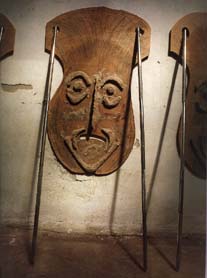 |
The heads are like masks, waiting until they can take on their role in the coming ritual In principle the mask is a material object, skilfully made and finished. In the ritual, however. it ceases to be just a soulless object; it becomes the spirit or the power that it represents The mask is the perfect intermediary between human beings (who wear it) and the spiritual.
The mask seems to be symbolic of the whole of Cornelius Rogge's oeuvre, summarized as a perpetual endeavour to approach that which can't be touched, which can't be penetrated. Therefore not only the work itself, the 'interpretation' too, every 'explanation' put forward to outflank unavoidably leads to the inexplicable. Each metamorphosis, each new form, in Rogge's mythology a vital necessity, fails to provide the observer with any new information. and only shows the riddle in a different guise.
In searching for the essence of existence, Rogge's work is like existence itself: tangible in its outermost forms but essentially mysterious. The actual meaning is hidden in the mystery.
Lisette Pelsers, July 1990
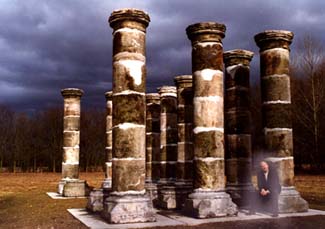 |
Rogge is a primitivist. He is a primitivist not unlike the way that Paul Gauguin was. Gauguin searched for the essences of persons unfettered by civilization. For Gauguin, civilization corrupts the aborigine and tears him from the idyllic life.
Rogge's art is also an art of essences. He hearkens back to the ancient Western histories to find those driving forces that endure in us.
His Wagon with Sword recalls ancient Celtic society. These Celts were aggressive marauders who sustained themselves, in part, by looting and exploiting others. His delicate, fast wagon carries only the load of the killing and maiming implement. It is a blitzkrieg machine - beautiful in parsimony, but monstrous in its purpose.
No modern viewer can help being moved by such images. "Aggressive marauders" who "loot and exploit" others might very well describe the countries and companies of the developed nations that raid non-industrialized nations for their resources and their labor. Human misery is the result. We could bring to these people medicine, education, longer lives, selfdetermination; but we bring them subsistence wages (or less). The exploited die prematurely, cast aside when they are used up by an economic and power-elite.
This image points out the ongoing human contradiction. The well-ordered wagon with rich patinas reifies the sword. And what good ever came from a sword? This wagon depends on the sword for its very existence. The sword is the lynchpin that holds all of the parts together. By making the sword art and gorgeous metal with a lyric shape, it becomes as romanticized and beautiful as a recruiting poster. This objectified external contradiction is our internal contradiction. We who say we love peace are all too ready to fight and rationalize the fight. In fact, from Gericault to U.S.Army television commercials, war and the tools of war are made beautiful in order to maintain that ancient lie Dulce et decorum est pro patria mori (it is sweet and proper to die for one's country). Rogge's work reveals the tragic irony concocted by societies.
David Courtney
For Dutch information reviews and recent exposions: click here
Recent major expositions:
RITUALS
< >
< >
< > Foreign translations:Page initiated: 8 February 1997; revised 2nd August 2021 For further information and response email to: wichm@NOSPAMxs4all.nl after deleting 'NOSPAM' from the address |